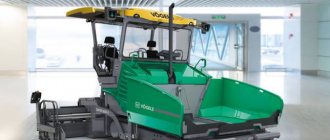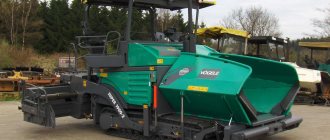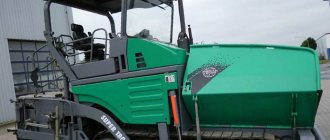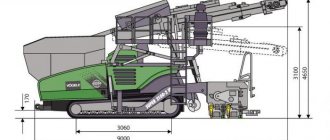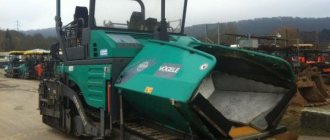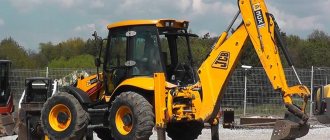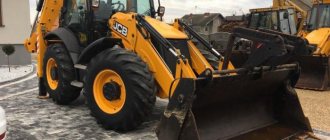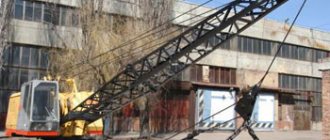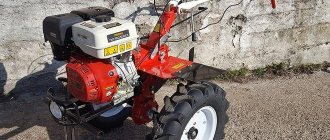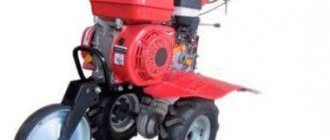The Vogele Super 1800-2 asphalt paver is a powerful, functional and compact example of modern equipment designed to carry out a large number of road works. Mass production of these products began in 2009. An article about other Vogele asphalt pavers is here.
From the first day of sale, the asphalt paver established itself as a unique model. It has no analogues among cars of its class.
Another truck that would be useful to read about is the Kamaz 6520 dump truck.
Comparison of the operating principles of an asphalt paver and other construction machines
In principle , construction machines such as a bulldozer with a leveling blade, grader or asphalt paver can be used to distribute and level the laid material during road construction work.
Asphalt paver , however, due to its design features, is more preferable for laying asphalt concrete compared to a bulldozer and grader. Yes, in fact, it was created specifically for this job.
Bulldozer with a planning blade. Since the blade is rigidly connected to the chassis through a hydraulic cylinder, the unevenness moved by the machine is not only not leveled by it, but even increases. Since the blade is located a short distance in front of the crawler tracks, only short bumps are slightly leveled out.
The asphalt paver carries out the laying with its working body, which is freely hung on the base machine and therefore “floats” over the material being laid. Thanks to this, the working element very effectively smoothes out small irregularities on the surface of the material without sending control commands to it (self-leveling effect). A simple calculation (see Section 1.4) shows that, taking into account the length of the support arms on which the working element is hung on the base machine, when it is in floating mode, the height of short irregularities can be reduced by approximately five times.
Warehouse liquidation! Hurry up to pick up at purchase prices
Therefore, pavers should be used starting from the installation of the lower layers of road pavement, so that the evenness of each subsequent layer continuously increases.
Bulldozer with planning blade
The bulldozer blade, located in front of the tracked vehicles, is rigidly connected to the chassis by means of a clamping rod.
Therefore, the irregularities moved by the machine are reproduced by the blade not only without compensation, but even with an increase if the corresponding commands are not sent to the hydraulic cylinder.
Grader
The blade of this machine, located between the front axle and the rear wheeled bogie, is rigidly connected to the center beam by a hydraulic cylinder. If the appropriate commands are not sent to the hydraulic cylinder, the bumps being moved are cut off or filled to a height less than the height of the bump, i.e. the surface of a certain stele is leveled
Asphalt paver
Here the connection of the working body with the chassis is not rigid; the working body is supported at a certain height by the laid material, i.e. it “floats” on the surface of the logo material. Its penetration into the material under the influence of its own weight changes only by changing its angle relative to the direction of towing by the base machine - the “angle of attack”. If the paver moves over bumps, the height of the towing points of the working body and, consequently, its angle of attack changes. Accordingly, the height of the working body also changes, but is less than the height of the irregularities, i.e. they are leveled and smoothed out
Main asphalt paver units
Asphalt pavers from VOGELE
Road pavers from VOGELE are designed both for laying all types of asphalt concrete mixtures and for laying subgrade materials. During asphalt concrete work, the asphalt concrete mixture unloaded from a dump truck is moved by scraper conveyors from the paver's receiving hopper to its working body, which, in fact, carries out the laying process. VOGELE asphalt pavers are distinguished above all by their high compaction, reliability, as well as ease of operation and maintenance.
1. Receiving hopper, thrust rollers
Dump trucks delivering the mixture unload it into a hopper located in front of the asphalt paver. In this case, in the process of transferring the mixture, the paver pushes the dump truck, resting against its wheels with its thrust rollers. Wide scraper conveyors transport the mixture through a tunnel running inside the paver to a screw chamber located in front of the working element. Equipped with a powerful engine, the paver can be mounted on either a wheeled or tracked undercarriage.
2. Scraper conveyors
Wide scraper conveyors transport the mixture through a tunnel running inside the paver to a screw chamber located in front of the working element.
3. Chassis
Equipped with a powerful engine, the paver can be mounted on either a wheeled or tracked undercarriage.
4. Distribution screws
The augers are designed to distribute evenly in front of the screed so that it can be laid with the required layer profile and compacted evenly. Therefore, the length of the augers must correspond to the layer width to which the working element is configured.
5. Working body
The working body of the asphalt paver is the very element that performs the task for which this machine was created. With its weight and the energy of its compacting units, it acts on the mixture, forming it into a layer of the required profile and pre-compacting it so that the layer can withstand the weight of the following roller, which performs the final compaction of the mixture.
6. Heaters
To prevent the mixture from sticking to the screed plates and compaction units (tamper and compaction strip (or strips)), they are heated during operation. Electric heater rods are used for this on UOCE1E pavers.
7. Leveling hydraulic cylinders
Unevenness of the base on which the new layer is laid is compensated by the asphalt pavers due to the fact that the angle of attack of the working body is accordingly adjusted by leveling hydraulic cylinders, which for this purpose change the height of the front ends of its supporting arms.
8. Hydraulic cylinder for unloading and blocking the working body
Depending on the operating conditions, the hydraulic cylinders for raising and lowering the working body change the pressure on it, unloading it to change the swimming parameters. When the cylinders are locked, the working element is blocked.
ENGINE
Vogele Super 1800 3 is equipped with a Cummins QSB6.7-C170 diesel unit. The engine is equipped with a liquid cooling mechanism and a multi-section radiator, which, together with innovative air supply, ensures the required temperature of the coolant and hydraulic oil. Uniform cooling allows the asphalt paver to work for a long time, regardless of climatic conditions and load levels. A turbocharging system with intercooling of the charge air allows the unit to show its maximum capabilities.
The engine has an ECO mode for low speed operation. Its use reduces fuel consumption and significantly reduces noise levels. The power plant complies with EPA Tier 3/Stage 3a environmental standards. The fuel tank holds up to 300 liters of fuel, which ensures operation without refueling for over 8 hours.
Characteristics of the Cummins QSB6.7-C170 engine:
- working volume – 6.7 l;
- rated power – 128 (174) kW (hp);
- power in ECO mode – 116 (157) kW (hp);
- rated speed – 2000 rpm;
- rotation speed in ECO mode – 1700 rpm;
- maximum torque – 800 Nm;
- number of cylinders – 6;
- cylinder diameter – 107 mm;
- specific fuel consumption – 228 g/kW per hour.
The principle of operation of the floating working body
The asphalt paver differs from other construction machines in its floating working body. In this case, the thickness of the laid layer changes only by changing the angle of attack of the working body or the height of its towing points. Thanks to this, the irregularities over which the paver moves can be leveled without sending control commands to its working element, i.e. automatically, due to self-leveling.
unevenness of the roadbed is compensated by a self-leveling floating working element
When moving over longer unevenness, the height of the towing points of the floating working element automatically changes, which leads to a change in the thickness of the laid layer
Depending on the angle of attack, as a result of the forward movement of the paver, a corresponding amount of mixture falls under its working element. Therefore, over longer sections, the layer thickness changes harmoniously.
The reaction of the working body to changes in the geometry of the base depends on the following factors:
- travel speed
- changing the height of the towing points of the working body,
- properties of the mixture, such as compactability, load-bearing capacity.
Working body of the tracked asphalt paver Vogele Super 1800-2
This main element of the asphalt paver can be a fixed width SB 250 or an extendable AB 500-2 or AB 600. In the basic configuration it is equipped with a screed and vibrators, and in the extended configuration it is equipped with a screed and 1 or 2 tamper bars.
The heating of the screed plate, vibrating screed and tamper ensures a uniform paving surface even when using extensions.
Working at low engine speeds, the machine generates the required amount of energy to heat the screed sealing system to operating temperature in a short time. This is carried out due to the control generator, which, with low fuel consumption, activates an additional mode for heating the working element (the right and left parts are heated separately).
Return to navigation
Theoretical foundations of self-leveling of a floating working body
Using the above example of a paver moving over a wave-like unevenness on the surface of the base, the geometric pattern shown on the right can be obtained. When moving over a short uneven base of height H, the working body will rise only to a height h in a ratio equal to the ratio of the length b (the sum of the lengths of its support arm and the screeding plate of the working body) to the length of this plate. Since this ratio is usually approximately 5:1, the height of the remaining unevenness on the surface of the laid layer will be approximately 5 times less than the height of the unevenness of the base. Irregularities occupying a longer area can only be compensated by actively adjusting the position of the working element using leveling cylinders.
NOTEThe evenness should increase as each subsequent layer is laid and, accordingly, depends on the geometry of the underlying layer.
SPECIFICATIONS
Dimensions:
- length without working element – 4757 mm;
- width without working element – 2550 mm;
- minimum width with mounted working element – 3265 mm;
- height with roof folded – 3100 mm;
- operating height – 3860 mm;
- ground clearance under the receiving hopper is 150 mm.
In the basic version, the curb weight of the Vogel Super 1800 3 is 19,400 kg. In transport mode, the speed of the asphalt paver can reach 4.5 km/h, in working mode – 24 m/min.
Operating parameters:
- laying thickness – 300 mm;
- feed system capacity – 700 tons/hour.
Pavers undercarriage options
VOGELE asphalt pavers are offered in two versions: wheeled or tracked. Both have their advantages.
Tracked pavers
maximum traction
is required for Since tracks have a larger contact area with the base than wheels, they can develop higher traction forces. In addition, with a crawler undercarriage, the torque is developed exactly where it is needed - at the hubs of the drive sprockets. This undercarriage allows the paver to work even on a wide variety of substrates, as well as with large paving widths of up to 16 m. Each track is controlled electronically. The paver even makes turns precisely, “as per the drawing,” with a constant laying speed. BENEFITS OF TRACK PAVERS
- High traction force
- Versatility of use
- Possibility of laying layers of large width.
- Ability to work even on soft ground
- Reliable pushing of heavy mix dump trucks
Wheeled pavers
Pavers on wheeled chassis have an advantage especially when changing jobs frequently. They can travel under their own power at speeds of up to 20 km/h, which often makes transporting them on a low-loader unnecessary if the new work site is located a relatively short distance away. In addition, VOGELE wheeled pavers are easy to manoeuvre, with a turning radius of just 6.5 m.
A high-quality pavement layer requires very smooth operation of the paver. Wheeled pavers optimally meet this requirement thanks to the pendulum suspension of the front wheels and the damping action of the rear wheels.
BENEFITS OF WHEEL PAVERS
- Driving under your own power on public roads at speeds of up to 20 km/h, which is ideal if you need to quickly and frequently change places of work if they are located close to each other
- Highly smooth operation when laying asphalt concrete layers
- Great maneuverability
- Constant contact of the front wheels with the base thanks to their pendulum suspension
Asphalt pavers and mix loaders from VOGELE
SUPER Series
VISION Series
POWERFEEDER Series
Application of asphalt pavers
Types of installation
Classic styling
Laying layers of multi-layer pavement on any roads and transport sites. These works can be performed on asphalt pavers of all sizes, with various working bodies. VOGELE asphalt pavers can lay layers from 2 to 40 cm thick.
Laying on a slope in the transverse direction
In addition to laying for normal road surfaces with possible uphill and downhill sections, asphalt pavers can also be used for laying on slopes and on the walls of landfills.
Typically, such work requires only minor modifications and alterations to the pavers. However, for very steep slopes, special pavers may be used that are technically specialized for such tasks.
Warehouse liquidation! Hurry up to pick up at purchase prices
Laying on a slope in the longitudinal direction
As an alternative to horizontal paving, asphalt pavers can also be used to work on slopes by laying the layer in the longitudinal direction of the slope. This requires only minor design modifications to the paver.
This laying method is often used in the construction of landfills and canals.
Construction of rutted roads and profiled surfaces
Special profiled coverings can be created using sliding working bodies, the geometry of which can be varied in a variety of ways.
A fracture of the main section of the working body allows the installation of a gable profile. Additionally, using the ability to change the height of individual elements of the sliding working body, it is possible to obtain M- and W-shaped profiles.
Using special formwork, it is possible to construct utility track roads and coverings with recesses for rail tracks.
The use of special formwork also allows installation on sharp turns, for example, during the construction of racing tracks.
Description and Application
The tracked paver under consideration is successfully used in large construction works, as well as in the formation of reliable and durable pavement in small areas, such as bicycle or pedestrian paths in recreation areas. Considering its dimensions, the Vogele super 1800 asphalt paver is capable of penetrating into the very recesses of parks and carrying out work at the proper level.
Among the main features of this asphalt paver, it is necessary to highlight the ability to perform work on compaction, leveling, and distribution of the coating. Moreover, despite the technical parameters, the level of compaction can vary in three classic zones:
- Short;
- Average;
- High.
Due to the presence of a tracked chassis, the unit is in a stable position regardless of the road situation. High traction allows you to overcome even areas with poor terrain. Taking into account the design features, as well as systems and innovative complexes, the presented model managed to take a leading position among its segment.
In addition to extremely high performance for its size, the equipment is characterized by improved control and greater efficiency. In addition, it was possible to introduce new stabilization and stability systems, which made it possible to increase maneuverability even in difficult areas. The Vogele 1800 asphalt paver guarantees that a wide range of work can be carried out in the most optimal time, without the involvement of other special equipment.
Application of asphalt pavers
SprayJet and InLine Pave technologies
Asphalt paver Super 1800-2 with SprayJet module
Laying a thin layer of asphalt concrete on a hot binder is one of the most cost-effective methods for resurfacing pavements. However, such installation requires the use of special machines.
The SUPER 1800-2 asphalt paver with the SprayJet module sprays bitumen emulsion onto the old pavement and lays a new layer on it in one pass. Construction vehicles no longer need to drive around areas covered with emulsion, as the new asphalt concrete immediately covers it. In other words, an optimal layer of binder is created, which guarantees a reliable connection of the layers. In addition, this technology eliminates contamination of the road near the installation site, since cars no longer drive over the distributed binder.
SprayJet technology is also ideal for laying thin layers of sound-absorbing asphalt concrete. At the same time, in order to form noise-absorbing cavities in the layer, its material should not be compacted to the same extent as when laying a conventional mixture. The use of traditional technology with two working passes would worsen the quality of the laying, since the layers would then have to be thicker, which, with less compaction, would lead to a decrease in the load-bearing capacity of the pavement.
InLine Pave technologies
In accordance with InLine Pave technology, the layers of binder and coating are laid, like compacted asphalt concrete, using the “hot layer on hot” method in one working pass, thanks to which not only a very strong connection of the layers is achieved, but also their intensive adhesion. At the same time, VOGELE machines designed for two-layer installation using this technology can also be used for installation in the traditional way, i.e. their operation becomes more profitable.
Days of operation using InLine Pave technology require three machines: a MT 3000-2 Offset mix loader, SUPER 2100-2 IP pavers for laying the binder layer and SUPER 1600-2 or SUPER 1800-2 for laying the coating. They line up one after the other, almost right next to each other.
First on this construction train is the loader. It receives binder and coating mixtures from trucks and alternately transfers them to the large optional hopper of the SUPER 2100-2 IP or to a transfer module that dumps the coating mixture into the hopper of the SUPER 1600-2 ( SUPER 1800-2). The stacker, following the loader, applies the binder layer. This layer is immediately compacted to a high degree of compaction (final) and therefore has a high load-bearing capacity. To perform this task, the paver is equipped with a special high-compaction working body VOGELE AB 600 TP2 Plus. SUPER 1600-2 ( SUPER 1800-2), applies a coating layer to the binder laid in this way
Maintenance
The wide hood and large hinged panels provide easy access to service points on the machine. All hydraulic pumps converge in one functional block. The presence of flexible hoses connecting working units allows you to reduce the number of threaded connections. To facilitate the lubrication of working units and mechanisms, the asphalt paver has a unified system for adding lubricant. This system lubricates all hinge mechanisms that come into contact with the hot mixture. The lubricant level is displayed on the operator’s display, which allows for quick addition of lubricant.
Tweet
